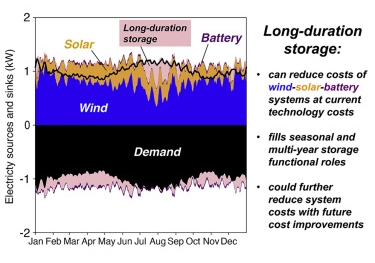Aug
12
Study Examines Long Term Energy Storage Technologies
August 12, 2020 | Leave a Comment
As more states in the U.S. push for increased reliance on variable renewable energy in the form of wind or solar power, long-term energy storage may play an important role in assuring reliability and reducing electricity costs, according to a new paper published by Caltech researchers in the journal Joule.
Graduate student Jackie Dowling, who works in the lab of Nathan Lewis (BS ’77), the George L. Argyros Professor and professor of chemistry, has collaborated with Ken Caldeira at the Carnegie Institution for Science and others to examine energy-storage options and multiple decades of data about wind and solar availability. Dowling and her collaborators determined that currently available battery technology is prohibitively expensive for long-term energy storage services for the power grid and that alternative technologies that can store a few weeks’ to a month’s worth of energy for entire seasons or even multiple years may be the key to building affordable, reliable renewable electricity systems.
Energy storage is needed with renewable energy because wind and solar energy are not as reliably available as fossil fuels. For example, wind power is often at its lowest during the summer in the United States, which is when the electrical grid is strained the most by the demand for air conditioning in homes and businesses.
Dowling, lead author of the paper about the work said, “This research is motivated by the fact that laws in several states have mandated 100 percent carbon-free electricity systems by mid-century. Within these mandates, a lot of states include requirements for wind and solar power. Both wind and solar are variable from day to day, or even year to year, yet high reliability is mandatory for a viable electricity system. Energy storage can fill in for the gaps between supply and demand.”
Dowling looked at short-duration storage systems, such as lithium-ion batteries, and long-duration storage methods, such as hydrogen storage, compressed-air storage, and pumped-storage hydroelectricity.
To see how to optimize the use of those storage technologies at the lowest energy cost, Dowling built a mathematical simulation of each and incorporated historical electricity-demand data and four decades of hourly resolved historical weather data across the contiguous U.S. The Macro Energy Model, as she calls it, reveals that adding long-duration storage to a wind-solar-battery system lowers energy costs. In contrast, using batteries alone for storage makes renewable energy more expensive.
Dowling said that the extra expense associated with batteries occurs because they cannot cost-effectively store enough energy for an entire season during which electricity is generated in lower amounts. That means an electrical grid would require many costlier solar panels or wind turbines to compensate and would result in wasteful idling of electricity-generation equipment for much of the year.
Currently available battery technology is not even close to being cost effective for seasonal storage, Dowling stated.
She explained, “The huge dip in wind power in the summer in the U.S. is problematic, and batteries are not suitable for filling that gap. So, if you only have batteries, you have to overbuild wind or solar capacity. Long-duration storage helps avoid the need to overbuild power generation infrastructure and provides electricity when people need it rather than only when nature provides it. At current technology costs, storage in underground caverns of green hydrogen generated by water electrolysis would provide a cost-effective approach for long-duration grid storage.”
Other researchers have built renewable energy models, but this team’s data-driven approach is the first to incorporate four decades of historical wind and solar variability data, thus factoring in variability from year to year and periodic episodes of rare weather events that affect power generation, such as wind and solar droughts.
“The more years of data we use in our models, the more we find a compelling need for long-term storage to get the reliability that we expect from an electricity system,” she noted.
Dowling suggests her findings may be helpful to policy makers in states with 100 percent carbon-free electricity laws and high wind/solar mandates and to other U.S. states considering the adoption of similar laws.
In the future, she plans to extend her research to take an in-depth look at the roles that specific types of energy storage, such as hydrogen or redox flow batteries, can play in renewable energy systems. For instance, she added, some types of batteries might effectively serve as medium-duration energy storage.
We’ve waited a long time indeed for this caliber of study to appear. Its been obvious from the start that batteries would be an economic disaster. The work is quite welcome, useful and a high value public service.
Perhaps there will come a day when renewables can be economically feasible. But the huge practical advantages that many fission nuclear technologies and the possible nuclear fusion concepts offer now and might offer in the future could, and probable should, end the environmental problems, immense sunk investment, maintenance expense, with taxpayer and consumer cost issues posed by today’s wind and solar technologies. So far and still, political views and special interests trump hard scientific energy production data.


